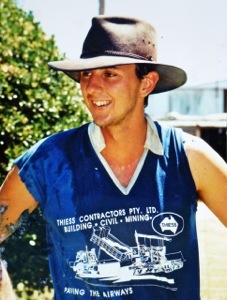 Two days ago I learned that Murray McNab lost his fight with colorectal cancer. I did not know Murray very well and we only exchanged a couple of emails, however his Journey struck a chord with me and I have been a regular visitor on his blog for the past 5 months. I guess its because he was pretty much the same age as me when diagnosed, and his initial diagnosis was virtually identical to mine. Stage 4 adenocarcinoma with extensive >70% mets to the liver and elsewhere.
Two days ago I learned that Murray McNab lost his fight with colorectal cancer. I did not know Murray very well and we only exchanged a couple of emails, however his Journey struck a chord with me and I have been a regular visitor on his blog for the past 5 months. I guess its because he was pretty much the same age as me when diagnosed, and his initial diagnosis was virtually identical to mine. Stage 4 adenocarcinoma with extensive >70% mets to the liver and elsewhere.
My heart goes out to Carmen and the rest of Murray’s family. I am very sorry for your loss, which has also impacted me deeply.
Just like me, Murray was a fighter and looked for and pursued alternative cancer treatments when traditional medicine offered little hope. I have always been in a good mental state, even after my initial diagnosis, always full of hope and resolve, despite the bleak 2 month prognosis. The last two days were different however and for the first time in the last 5 months I feel myself sinking into a deep state of depression. I guess Murray’s death finally brought home the realities of this dreadful disease.
I came across Murray’s site while researching the Photodynamic Therapy (PDT) for cancer. At that time he had already pursued this procedure in China. His reported results were not great so I researched PDT in more detail. I came to the conclusion that PDT or SPDT were the wrong choice for metastatic colorectal cancer. PDT introduces photosensitive chemicals into tumour cells, and these need to be activated by light. In China this is done by shining red light through the skin in an effort to reach the tumour cells. There is just no way that light applied in this way can reach mets deep inside the liver. In Europe some PDT clinics apply light laparoscopically, which is a much better approach, but I still doubt that it will reach mets deep inside the liver tissue. I am very thankful that Murray shared his journey as I avoided making the same mistake with this treatment.
I first contacted Murray to find out why he had not pursued directed liver therapies in light of his extensive liver mets. In his reply he explained that due to his lung and bone mets, he was advised that liver directed therapies would not be appropriate as they would not treat the other mets. This is exactly the same advice that my oncologist gave me. I however did not agree with this advice. I contacted the top SIRT, TACE and Liver surgeons for second and third opinions. As it turns out, there is no reason not to pursue liver directed therapies such as TACE and SIRT at the same time as systemic chemo. Even a two stage liver resection with portal vein ligation can be performed on livers with extensive Mets.
After SPDT, Murray travelled to Germany to undergo a 3 week whole body hyperthermia treatment at the Herzog clinic. Hyperthermia is ideal to try in combination with immunotherapies. Murray was looking into these as well, but was advised that a low tumour load is needed for these to work. He never achieved this however. His Hyperthermia results were not great and he returned to Australia in a worse shape. Again I am very thankful for the insight into Murray’s experience. I too am heading off to Germany next month for a range of treatments, including hyperthermia. I will however do immunotherapies like dendritic cell vaccines and oncoviruses concurrently. Hyperthermia can stimulate the immune system, but not likely to be of benefit on its own with mCRC it seems.
Murray has been an inspiration and the main reason for this blog is to also share my treatment decisions and experiences with others. I am hoping that it can also help and inspire others going through the same ordeals, just as Murray has helped and inspired me.
Thank you Murray.

One Response to Murray McNab (-14/3/2013)